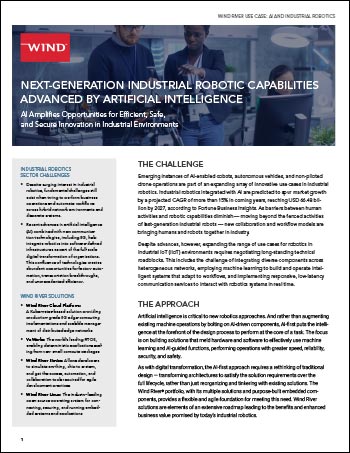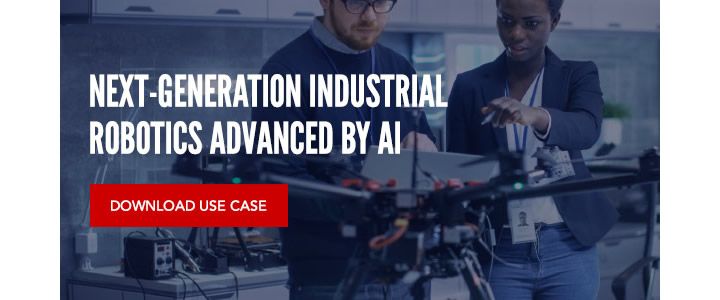As barriers between human activities and robotic capabilities diminish — moving beyond the fenced activities of last-generation industrial robots — new collaboration and workflow models are bringing humans and robots together in industry.
Case Study from | Wind River
THE CHALLENGE
 Emerging instances of AI-enabled cobots, autonomous vehicles, and non-piloted drone operations are part of an expanding array of innovative use cases in industrial robotics. Industrial robotics integrated with AI are predicted to spur market growth by a projected CAGR of more than 15% in coming years, reaching USD 66.48 billion by 2027, according to Fortune Business Insights. As barriers between human activities and robotic capabilities diminish — moving beyond the fenced activities of last-generation industrial robots — new collaboration and workflow models are bringing humans and robots together in industry. Despite advances, however, expanding the range of use cases for robotics in Industrial IoT (IIoT) environments requires negotiating long-standing technical roadblocks. This includes the challenge of integrating diverse components across heterogeneous networks, employing machine learning to build and operate intelligent systems that adapt to workflows, and implementing responsive, low-latency communication services to interact with robotics systems in real time.
Emerging instances of AI-enabled cobots, autonomous vehicles, and non-piloted drone operations are part of an expanding array of innovative use cases in industrial robotics. Industrial robotics integrated with AI are predicted to spur market growth by a projected CAGR of more than 15% in coming years, reaching USD 66.48 billion by 2027, according to Fortune Business Insights. As barriers between human activities and robotic capabilities diminish — moving beyond the fenced activities of last-generation industrial robots — new collaboration and workflow models are bringing humans and robots together in industry. Despite advances, however, expanding the range of use cases for robotics in Industrial IoT (IIoT) environments requires negotiating long-standing technical roadblocks. This includes the challenge of integrating diverse components across heterogeneous networks, employing machine learning to build and operate intelligent systems that adapt to workflows, and implementing responsive, low-latency communication services to interact with robotics systems in real time.
THE APPROACH
Artificial intelligence is critical to new robotics approaches. And rather than augmenting existing machine operations by bolting on AI-driven components, AI-first puts the intelligence at the forefront of the design process to perform at the core of a task. The focus is on building solutions that meld hardware and software to effectively use machine learning and AI-guided functions, performing operations with greater speed, reliability, security, and safety. As with digital transformation, the AI-first approach requires a rethinking of traditional design — transforming architectures to satisfy the solution requirements over the full lifecycle, rather than just reorganizing and tinkering with existing solutions. The Wind River® portfolio, with its multiple solutions and purpose-built embedded components, provides a flexible and agile foundation for meeting this need. Wind River solutions are elements of an extensive roadmap leading to the benefits and enhanced business value promised by today’s industrial robotics.
To learn how AI-first puts the intelligence at the forefront of the design process to perform at the core of industrial robotics, read this Wind River use case, “Next-Generation Industrial Robotic Capabilities Advanced by Artificial Intelligence”.
The content & opinions in this article are the author’s and do not necessarily represent the views of RoboticsTomorrow
Comments (0)
This post does not have any comments. Be the first to leave a comment below.
Featured Product


